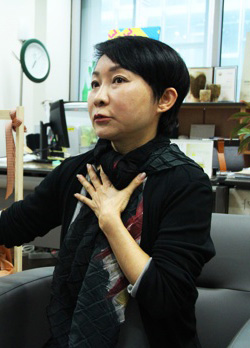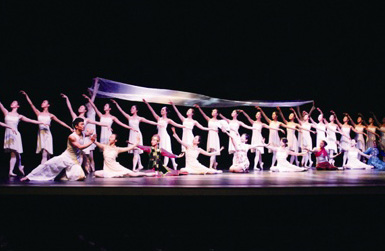
Becoming the master of your own body and soul, and having self-respect when performing is how professor Cho Ki-sook (Dance) defines the act of dancing. Strict forms are often blurred in Cho’s work with the concepts of independence and embracement, which she believes as an Ewha graduate are the spirits of the university, are ingrained in her work. Renowned for her performance of the New Swan Lake Series, Cho reconstructed the dance from the viewpoint of every swan rather than from the perspective of the prince alone. A noticeably petite ballerina, Cho now stands as a pioneer in the field of “New Ballet” in Korea. “New Ballet” is a term first coined by a Russian dancer and choreographer Michel Fokine in 1904, but was first introduced to Korea in performances by Cho. Its performances differ from the traditional ballet in that it makes the dancers as the prime focus rather than the story itself. “Ballet is a dance that originated from King Louis XIV, who performed it in front of his aristocrats,” Choi said. “Therefore, when ballerinas perform, they are performing an authoritative form of dancing, a dance of a king,” Cho said. “On the contrary, ‘New Ballet’ is a dance for the dancers themselves —it does not have a storyline or a luxurious palace background with royal families, but the performing ballerinas are its main compositions.” As “New Ballet” tells the dancers’ own stories and starts from their own bodies, it has no limits in its forms of performance. This has allowed Cho to plan a performance blending Korean traditional music into her works. For her last performance at the Chapel in Ewha, Cho included physically challenged dancers, breaking from the traditional form of ballet, which usually consists of only professional dancers. Cho also tried many pieces with pop art, Beat Box and Extreme Bike. “To convey our Korean spirits I believe we need to make our own form,” Cho said.

“That uniqueness of content and structure will be competitive on the global stage.” In a similar vein, Cho once fell into the dilemma of whether she should continue ballet, which originated in the West, as she felt it went against her identity as a Korean. She pondered, and only recently, in her 50s, has she found the answer to such questions. When she visited Paris, she noticed that every statue on the Notre Dame Cathedral had wings, and most were humans. “I discovered since ancient times there were so many myths about ‘birdmen’—humans have long desired to fly and soar, from the bottom of their hearts,” Cho said. “From then on, I realized that ballet was the best form of performance to express this desire.” Cho further explained the meaning of this through ballet. “Ballet is not only about techniques, but is a performance with a combination of intelligence, emotion and research,” she said. “To go beyond the standard techniques, dancers must research and develop their movements and bodies as they grow, and evolve from there on.” However, Cho suggests that people must always keep in mind that we are not living on our own in this world, and remember the history of Ewha as Ewha students. “Ewha was founded by Mary F. Scranton, an American missionary, who came to Korea to provide education opportunities for the poor,” Cho said. “Like Scranton, I hope Ewha students always remember that we live amongst others, thus it is crucial to embrace others.” Cho further advises the future ballerinas to live autonomous lives and lead dance careers. “Think of a liver, an independent organ in our body system,” she said. “If it cannot do its own duty, we will soon become susceptible to illness. However, at the same time, the liver itself cannot exist alone. The function of the liver is also important. We should also remember to embrace others as the body does with its organs.”

